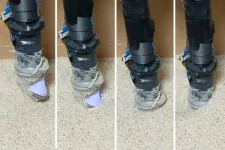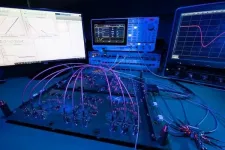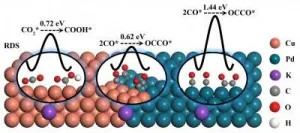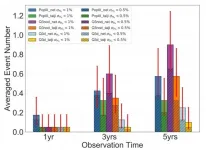(Press-News.org) Over the years, robots have gotten quite good at identifying objects -- as long as they're out in the open.
Discerning buried items in granular material like sand is a taller order. To do that, a robot would need fingers that were slender enough to penetrate the sand, mobile enough to wriggle free when sand grains jam, and sensitive enough to feel the detailed shape of the buried object.
MIT researchers have now designed a sharp-tipped robot finger equipped with tactile sensing to meet the challenge of identifying buried objects. In experiments, the aptly named Digger Finger was able to dig through granular media such as sand and rice, and it correctly sensed the shapes of submerged items it encountered. The researchers say the robot might one day perform various subterranean duties, such as finding buried cables or disarming buried bombs.
The research will be presented at the next International Symposium on Experimental Robotics. The study's lead author is Radhen Patel, a postdoc in MIT's Computer Science and Artificial Intelligence Laboratory (CSAIL). Co-authors include CSAIL PhD student Branden Romero, Harvard University PhD student Nancy Ouyang, and Edward Adelson, the John and Dorothy Wilson Professor of Vision Science in CSAIL and the Department of Brain and Cognitive Sciences.
Seeking to identify objects buried in granular material -- sand, gravel, and other types of loosely packed particles -- isn't a brand new quest. Previously, researchers have used technologies that sense the subterranean from above, such as Ground Penetrating Radar or ultrasonic vibrations. But these techniques provide only a hazy view of submerged objects. They might struggle to differentiate rock from bone, for example.
"So, the idea is to make a finger that has a good sense of touch and can distinguish between the various things it's feeling," says Adelson. "That would be helpful if you're trying to find and disable buried bombs, for example." Making that idea a reality meant clearing a number of hurdles.
The team's first challenge was a matter of form: The robotic finger had to be slender and sharp-tipped.
In prior work, the researchers had used a tactile sensor called GelSight. The sensor consisted of a clear gel covered with a reflective membrane that deformed when objects pressed against it. Behind the membrane were three colors of LED lights and a camera. The lights shone through the gel and onto the membrane, while the camera collected the membrane's pattern of reflection. Computer vision algorithms then extracted the 3D shape of the contact area where the soft finger touched the object. The contraption provided an excellent sense of artificial touch, but it was inconveniently bulky.
For the Digger Finger, the researchers slimmed down their GelSight sensor in two main ways. First, they changed the shape to be a slender cylinder with a beveled tip. Next, they ditched two-thirds of the LED lights, using a combination of blue LEDs and colored fluorescent paint. "That saved a lot of complexity and space," says Ouyang. "That's how we were able to get it into such a compact form." The final product featured a device whose tactile sensing membrane was about 2 square centimeters, similar to the tip of a finger.
With size sorted out, the researchers turned their attention to motion, mounting the finger on a robot arm and digging through fine-grained sand and coarse-grained rice. Granular media have a tendency to jam when numerous particles become locked in place. That makes it difficult to penetrate. So, the team added vibration to the Digger Finger's capabilities and put it through a battery of tests.
"We wanted to see how mechanical vibrations aid in digging deeper and getting through jams," says Patel. "We ran the vibrating motor at different operating voltages, which changes the amplitude and frequency of the vibrations." They found that rapid vibrations helped "fluidize" the media, clearing jams and allowing for deeper burrowing -- though this fluidizing effect was harder to achieve in sand than in rice.
They also tested various twisting motions in both the rice and sand. Sometimes, grains of each type of media would get stuck between the Digger-Finger's tactile membrane and the buried object it was trying to sense. When this happened with rice, the trapped grains were large enough to completely obscure the shape of the object, though the occlusion could usually be cleared with a little robotic wiggling. Trapped sand was harder to clear, though the grains' small size meant the Digger Finger could still sense the general contours of target object.
Patel says that operators will have to adjust the Digger Finger's motion pattern for different settings "depending on the type of media and on the size and shape of the grains." The team plans to keep exploring new motions to optimize the Digger Finger's ability to navigate various media.
Adelson says the Digger Finger is part of a program extending the domains in which robotic touch can be used. Humans use their fingers amidst complex environments, whether fishing for a key in a pants pocket or feeling for a tumor during surgery. "As we get better at artificial touch, we want to be able to use it in situations when you're surrounded by all kinds of distracting information," says Adelson. "We want to be able to distinguish between the stuff that's important and the stuff that's not."
INFORMATION:
Funding for this research was provided, in part, by the Toyota Research Institute through the Toyota-CSAIL Joint Research Center; the Office of Naval Research; and the Norwegian Research Council.
Written by Daniel Ackerman, MIT News Office
Paper: "Digger Finger: GelSight Tactile Sensor for Object Identification Inside Granular Media"
https://arxiv.org/pdf/2102.10230.pdf
A mathematical model which can predict landslides that occur unexpectantly has been developed by two University of Melbourne scientists, with colleagues from GroundProbe-Orica and the University of Florence.
Professors Antoinette Tordesillas and Robin Batterham led the work over five years to develop and test the model SSSAFE (Spatiotemporal Slope Stability Analytics for Failure Estimation), which analyses slope stability over time to predict where and when a landslide or avalanche is likely to occur.
In a study published in Scientific Reports, the research team was ...
Discovered by Victor Hess in 1912, cosmic rays, relativisitic particles that shower Earth, contribute a signicant part of the energy density in the universe and carries unambiguous informations on various astrophysical processes . Yet until now, origin of cosmic rays is still a mystery.
A key problem in understanding the origin of cosmic rays is the searching for the acceleration site up to or even beyond Ultra-high energy (UHE). Such extreme accelerators are dubbed as PeVatrons. However, composed of subatomic particles, such as protons or atomic nuclei, cosmic rays are charged and lose ...
Using intermittent electric energy to convert excessive CO2 into C2 products, such as ethylene and ethanol, is an effective strategy to mitigate the greenhouse effect. Copper (Cu) is the only single metal catalyst which can converts CO2 into C2 products by electrochemical method, but with undesirable selectivity of C2 product. Therefore, how to improve the conversion efficiency of Cu-based catalysts for reducing CO2 to C2 product has attracted great attention.
Recently, a research team led by Prof. Min Liu from Central South University, China designed a Cu-Pd bimetallic electrocatalyst possessing CuPd(100) interface which can lower the energy barrier of C2 product generation. The electrocatalyst was obtained through using ...
WASHINGTON--People who eat too many refined carbs and fatty meats for dinner have a higher risk of heart disease than those who eat a similar diet for breakfast, according to a nationwide study published in the Endocrine Society's Journal of Clinical Endocrinology & Metabolism.
Cardiovascular diseases like congestive heart failure, heart attack and stroke are the number one cause of death globally, taking an estimated 17.9 million lives each year. Eating lots of saturated fat, processed meats and added sugars can raise your cholesterol and increase your risk of heart disease. Eating a heart-healthy diet with more whole carbohydrates like vegetables and grains and less meat can significantly offset the risk of cardiovascular disease.
"Meal timing along with food quality are important factors ...
The farming of livestock to feed the global appetite for animal products greatly contributes to global warming. A new study however shows that emission intensity per unit of animal protein produced from the sector has decreased globally over the past two decades due to greater production efficiency, raising questions around the extent to which methane emissions will change in the future and how we can better manage their negative impacts.
Despite what we know about the environmental cost of livestock production, the global appetite for animal products such as meat, eggs, and dairy continues to grow. The livestock sector is in fact the largest source of manmade methane emissions globally, and these emissions are projected ...
A team of international researchers has found that the Tsimane indigenous people of the Bolivian Amazon experience less brain atrophy than their American and European peers. The decrease in their brain volumes with age is 70% slower than in Western populations. Accelerated brain volume loss can be a sign of dementia.
The study was published May 26, 2021 in the Journal of Gerontology, Series A: Biological Sciences and Medical Sciences.
Although people in industrialized nations have access to modern medical care, they are more sedentary and eat a diet high in saturated fats. In contrast, the Tsimane ...
UC San Francisco researchers have found a way to double doctors' accuracy in detecting the vast majority of complex fetal heart defects in utero - when interventions could either correct them or greatly improve a child's chance of survival - by combining routine ultrasound imaging with machine-learning computer tools.
The team, led by UCSF cardiologist Rima Arnaout, MD, trained a group of machine-learning models to mimic the tasks that clinicians follow in diagnosing complex congenital heart disease (CHD). Worldwide, humans detect as few as 30 to 50 percent of these conditions before birth. However, the combination of human-performed ultrasound ...
University of Virginia School of Medicine scientists have developed important new resources that will aid the battle against cancer and advance cutting-edge genomics research.
UVA's Chongzhi Zang, PhD, and his colleagues and students have developed a new computational method to map the folding patterns of our chromosomes in three dimensions from experimental data. This is important because the configuration of genetic material inside our chromosomes actually affects how our genes work. In cancer, that configuration can go wrong, so scientists want to understand ...
Hundreds of antibiotic resistant genes found in the gastrointestinal tracts of Danish infants
Danish one-year-olds carry several hundred antibiotic resistant genes in their bacterial gut flora according to a new study from the University of Copenhagen. The presence of these genes is partly attributable to antibiotic use among mothers during pregnancy.
An estimated 700,000 people die every year from antibiotic resistant bacterial infections and diseases. The WHO expects this figure to multiply greatly in coming decades. To study how antibiotic resistance occurs in humans' ...
The Hubble parameter is one of the central parameters in the modern cosmology. Their values inferred from the late-time observations are systematically higher than those from the early-time measurements by about 10%. This is called the "Hubble tension". To come to a robust conclusion, independent probes with accuracy at percent levels are crucial. With the self-calibration by the theory of general relativity, gravitational waves from compact binary coalescence open a completely novel observational window for Hubble parameter determination. Hence, it can shed some light on the Hubble tension. Depends on whether being associated with ...





